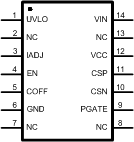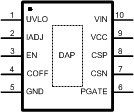SNVS602L March 2009 – June 2016 LM3409 , LM3409-Q1 , LM3409HV , LM3409HV-Q1
PRODUCTION DATA.
- 1 Features
- 2 Applications
- 3 Description
- 4 Revision History
- 5 Device Comparison Table
- 6 Pin Configuration and Functions
- 7 Specifications
-
8 Detailed Description
- 8.1 Overview
- 8.2 Functional Block Diagram
- 8.3 Feature Description
- 8.4 Device Functional Modes
-
9 Application and Implementation
- 9.1
Application Information
- 9.1.1 Input Undervoltage Lockout (UVLO)
- 9.1.2 Operation Near Dropout
- 9.1.3 LED Ripple Current
- 9.1.4 Buck Converters without Output Capacitors
- 9.1.5 Buck Converters With Output Capacitors
- 9.1.6 Output Overvoltage Protection
- 9.1.7 Input Capacitors
- 9.1.8 P-Channel MOSFET (PFET)
- 9.1.9 Re-Circulating Diode
- 9.2
Typical Applications
- 9.2.1 EN PIN PWM Dimming Application for 10 LEDs
- 9.2.2 Analog Dimming Application for 4 LEDs
- 9.2.3 LM3409 Buck Converter Application
- 9.1
Application Information
- 10Power Supply Recommendations
- 11Layout
- 12Device and Documentation Support
- 13Mechanical, Packaging, and Orderable Information
Package Options
Mechanical Data (Package|Pins)
Thermal pad, mechanical data (Package|Pins)
- DGQ|10
Orderable Information
6 Pin Configuration and Functions
NFF Package
14-Pin PDIP
Top View

Pin Functions
| PIN | DESCRIPTION | ||
|---|---|---|---|
| NAME | PDIP | HVSSOP | |
| UVLO | 1 | 1 | Input undervoltage lockout. Connect to a resistor divider from VIN and GND. Turn-on threshold is 1.24 V and hysteresis for turnoff is provided by a 22 µA current source. |
| IADJ | 3 | 2 | Analog LED current adjust. Apply a voltage from 0 to 1.24 V, connect a resistor to GND, or leave open to set the current sense threshold voltage. |
| EN | 4 | 3 | Logic level enable and PWM dimming. Apply a voltage >1.74 V to enable device, a PWM signal to dim, or a voltage < 0.5 V for low-power shutdown. |
| COFF | 5 | 4 | Off-time programming. Connect resistor from VO, capacitor to GND to set off-time. |
| GND | 6 | 5 | Connect to system ground. |
| PGATE | 9 | 6 | Gate drive. Connect to gate of external P-channel MOSFET. |
| CSN | 10 | 7 | Negative current sense. Connect to negative side of sense resistor. |
| CSP | 11 | 8 | Positive current sense. Connect to positive side of sense resistor (also to VIN). |
| VCC | 12 | 9 | VIN– referenced linear regulator output. Connect at least a 1-µF ceramic capacitor to VIN. The regulator provides power for the P-channel MOSFET drive. |
| VIN | 14 | 10 | Input voltage. Connect to the input voltage. |
| Thermal pad | — | Connect to GND pin. Place 4 to 6 vias from thermal pad to GND plane. | |
